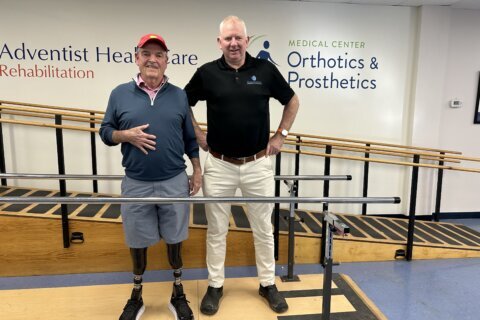A screening procedure that started as a pilot program in the D.C. area is credited with saving the lives of babies around the world.
Pulse oximetry (or “pulse ox”) is simple, cheap, painless and quick. It involves an oximeter — that little clip that is placed on a finger to check blood oxygen levels.
This same technology can also screen for congenital heart disease in babies, and it was developed at Children’s National Hospital.
Dr. Gerard Martin, a longtime pediatric cardiologist at Children’s National Hospital, led the development of the test with other doctors over a decade ago.
“Most people don’t know it, but heart disease is the No. 1 birth defect in children,” Martin said. “It affects nearly one out of every 100 babies. In that one in 100 babies, about a third of those have a particularly dangerous form called critical congenital heart disease.”
If that heart disease is not caught by the time those babies leave the hospital, they can get very sick at home or even die.
“The normal amount of oxygen in the bloodstream is 98–100%. Babies with heart disease get levels of oxygen that are less than 95%,” he said.
While many think it’s easy to know a baby’s oxygen is low because their skin turns blue, that’s actually an indicator that doesn’t appear until when the oxygen is quite low, Martin said.
“The problem is, the human eye doesn’t detect it often until the number is less than 70%,” he said.
But this testing will catch a child whose oxygen levels are above 70%, but below 95%. It will trigger a warning that something isn’t quite right, so tests can then be done to diagnose the baby’s ailment.
The screening, which is now a mandatory part of newborn screening panels in the United States, is credited with saving 300 lives a year here. But it wasn’t always mandatory.
Research shows the states that were early adapters had a 33% reduction in infant mortality linked to congenital heart disease, compared with the state’s that didn’t mandate it.
Martin is currently working to get the test used around the world, where it’s expected to save almost 700,000 new lives by 2030.
In addition to heart disease, the pulse ox test can pick up other conditions including pneumonia, sepsis and other lung problems that could threaten a baby’s life without treatment.
Martin told a story of his realization that he created something that is making a difference. He was speaking on Capitol Hill to a group of parents when a young mother came up to him in tears and asked him to take a picture with her.
“I said, ‘Sure, but can you tell me why you’re crying and why you want a picture with me?’” he recalled. “She said: ‘My baby was the first baby found in the state of Virginia with that test that you advocated for. You saved my baby’s life, and I wanted to meet you.’
“Those are the chilling stories that you get that you know you’ve done something that’s good,” Martin said.








